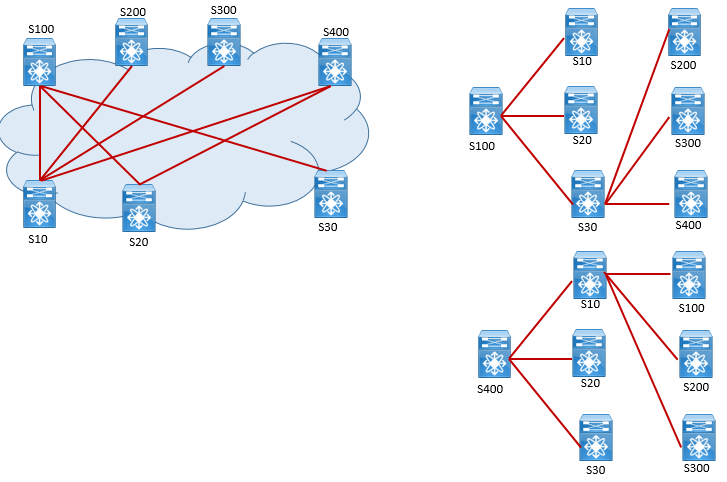EMAIL SUPPORT
dclessons@dclessons.comLOCATION
USPacket Flow in FabricPath
In order to send traffic in fabric path domain, Once Network administrator has configured the Fabric Path correctly, Switch table and other table like Multi destination tree will already be created.
In previous section we have given idea about how switch table will be created now we will learn how Multidestination tree along with MAC table will be populated and then how data traffic will flow between source and destination.
Following are the table types which will be used for following types of table.
- For Broadcast, unknown unicast, and Multicast: Multidestination tree, MAC table is used.
- For Unicast traffic (data traffic): Switch table and MAC Table is used.
Now we will see how multidestination tree is created to handle broadcast, unknown unicast, and Multicast traffic.
Multidestination Trees:
For broadcast (ARP Request), unknown unicast (ARP Reply in fabric path only), and multicast, multidestination trees are created. In fabric path domain two multidestination trees are created for which two root switch to be defined. Root Switch can be define or elected by following method.
- Root Priority: 8 bit value between 0 and 255 (default value is 64)
- System ID: 48 bit composed of VDC MAC address
- Switch ID: 12 Bit unique SID.
In this domain, one switch become root for multidestination Tree 1 by using values. Higher values will be used for Root Switch Negotiation. Once a switch becomes root for Multidestination Tree 1 then second root switch will be negotiated by using these values among other switches. So by this we have two root switch one root switch for Multidestination Tree 1 and second root switch for Multidestination Tree 2.
By root-Priority command you can also define manual Priority of any switch.
Once Root Switch is defined, Root Switches will create multidestination Tree (Tree-1 and Tree-2) based on shortest path to reach to all other switches in fabric path domain.
Below diagram can explain what we have read above:

Out of above switch two root Switches S100 for Tree-1 and S400 for Tree-2 is defined. Now S100 and S400 will create its respective Multidestination based on shortest path to reach other switches.
Before Going to How data traffic flows and how ARP request and ARP reply works, Lets understand how MAC address learning occurs in Fabric Path domain.
Fabric Path Conversational MAC Learning:
In this there is a rule defined in MAC address learning in fabric Path domain which states that only Cisco fabric Path edge switch will populate the MAC table and use MAC address table to forward frames, whereas Core switches will not learn the MAC address and frame forwarding with in fabric is based on the outer destination address of Fabric path header.
When MAC table is populated in Fabric Path, there will be two types of entry, local and remote.
- Local MAC address entry: Any MAC address of host which is directly connected to switch.
- Remote MAC address entry: Any MAC address which is connected on different fabric Path enabled switches and is learned after bi-direction communication has been established.
In order to learn the MAC address as remote address there is rule, for unicast frames, received switch will learn the Source MAC address as remote MAC address entry only if the destination MAC address matches an already learned local MAC address entry. Switch learns remote MAC addresses only if the remote device is having a bidirectional conversation with a locally connected device; unknown unicast frames being flooded in the Cisco Fabric Path network do not necessarily trigger learning on edge switches.
MAC address learning on Mixed VDC has different procedure, we will discuss here, let’s suppose you have switch which have M1 line card and has connectivity to L3 Outside network and also has F1 module connected to Fabric path domain. So in this scenario the MAC addresses of any hosts behind a particular Cisco Fabric Path core port are learned as remote MAC address entries on the forwarding engine ASIC controlling that core port.
Cisco fabric Path Packet Forwarding:
Here we will discuss two host communicates with each other in fabric Path domain. Let suppose Host A and Host B in same VLAN 10 wants to communicate with each other, Host A connected to Switch ID S10 and Host B is connected to Switch S30 Switch.





LEAVE A COMMENT
Please login here to comment.